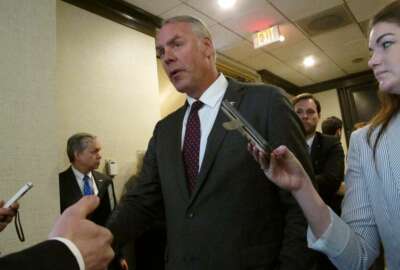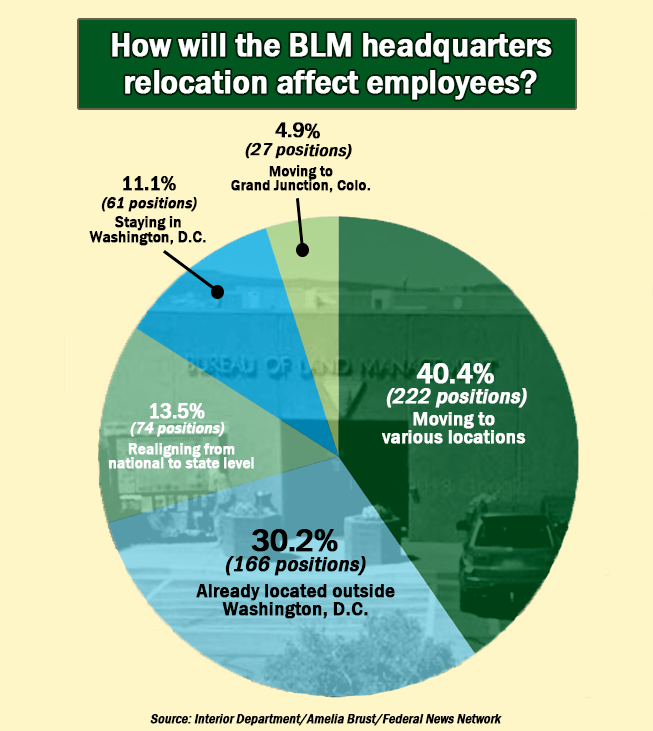

Though the Interior Department announced plans to relocate its headquarters for the Bureau of Land Management to Grand Junction, Colorado, more BLM employees will...
Another federal agency has announced plans to relocate a few hundred of its employees out of the Washington, D.C. metropolitan area.
The Interior Department said Tuesday it plans to relocate and establish a new headquarters for the Bureau of Land Management in Grand Junction, Colorado.
“Because of the incredibly high cost of real estate and lease costs, as well as the locality pay differential that employees in the D.C. metro area receive, that moving the headquarters to another location was going to result in a significant savings, almost regardless of where we might put the headquarters,” Joe Balash, Interior’s assistant secretary for land and minerals management, told reporters Tuesday afternoon.
Sen. Cory Gardner (R-Colo.) announced Monday that the department would relocate the BLM headquarters to his state.
BLM’s decision to relocate is part of Interior’s broader efforts to reorganize and realign management functions within the department. Interior last summer announced plans to establish 12 unified regions, led by area facilitators, across all of its bureaus.
 Balash described a detailed effort to evaluate the functions of all of the 550 positions that currently have direct ties to the bureau’s headquarters in Washington. Interior questioned whether each position needed to be located in D.C. and physically situated near the BLM director’s office.
Balash described a detailed effort to evaluate the functions of all of the 550 positions that currently have direct ties to the bureau’s headquarters in Washington. Interior questioned whether each position needed to be located in D.C. and physically situated near the BLM director’s office.
Of those headquarters positions, 166 are already situated outside of the Washington area, mostly in western states.
Interior has chosen to take a variety of paths to relocate and realign the remaining 384 headquarters positions.
Roughly 27 positions, including BLM’s director, deputy director for operations and assistant directors, will relocate to Grand Junction, Colorado, which will serve as the bureau’s new headquarters.
Seventy-four positions are no longer necessary to the national BLM level, Balash said, and will move to the bureau’s state offices.
“Those positions have been reallocated to the states,” he said. “The [full-time equivalents and] the money behind that FTE is going to be allocated to individual state offices for use by those state offices to carry out their mission at the state, district and field levels.
The remaining 222 positions will move to various locations depending on their mission, job function and program area.
Employees who work for BLM’s timber program, for example, would relocate to Oregon, where most resources are currently situated.
“They are responsible for developing timber resources on BLM lands and then sharing those resources with local counties,” Balash said. “Most of the program staff are out in Oregon. The head of that program is right here in Washington, D.C. It makes much more sense for that position to be located with the rest of the program staff out there in Oregon.”
Other employees who handle grazing permits will relocate to Idaho, Balash said.
Employees who handle BLM’s budget, congressional and regulatory affairs and Freedom of Information Act compliance, about 61 people in total, will remain in Washington.
The deputy director for policy and programs will also stay in Washington. Each of BLM’s directorates will also have a program coordinator who will stay within the region, Balash added.

Interior isn’t the first agency to propose relocation out of the Washington, D.C. metropolitan area. The Agriculture Department recently announced its plans to relocate employees at the Economic Research Service and National Institute of Food and Agriculture to Kansas City.
But Interior’s plans for relocation appear to differ significantly from what USDA is currently pursuing. The USDA relocation plan has faced backlash from a variety of lawmakers, mostly Democrats.
Though USDA told employees it planned to move them out of the Washington metropolitan area a year ago, it didn’t announce a site location until June.
USDA employees had until July 15 to decide whether they would relocate to Kansas City. USDA expects to start moving some employees in August, with the goal of having the relocations largely completed by Sept. 30.
But Balash said the transition for most BLM employees would take 15 months or longer.
“We are working with each individual employee to identify whether they, in fact, want to move, and if they do what timing best suits their personal and professional situation,” he said. “We spent some time both yesterday afternoon and this morning talking with our Washington-based BLM employees and outlining the decisions that have been made and the resources that they will have available to help them make up their minds and talk with their families about the right course of action for them.”
Interior acknowledged not all BLM employees will choose to relocate. The department plans to grant priority for other positions within the bureau and Interior to BLM employees who deny relocation.
The BLM relocation will save Interior $50 million over the next 20 years, though Balash said that figure was a conservative estimate. The department didn’t assume or calculate the potential costs of employee attrition in its estimates. Ultimately, Interior said the cost savings “are going to be more significant than we can demonstrate today.”
“A lot of that is going to come down to, ultimately, how much lease space we need to acquire and what our relocation costs for the employees will turn out to be,” Balash said of the estimated savings.
Susan Combs, Interior’s assistant secretary for policy, management and budget, said the BLM relocation would also save the department time, travel and money by having more key decision-makers in the field.
“From a policy perspective, from a management perspective and from an accountability perspective, the American public that is interested in BLM will be very glad that they can then go talk to the individual man or woman decision maker without having to travel a long way to the East Coast,” she said.
Interior already has facilities in Denver and Grand Junction, Colorado. The department will work with the General Services Administration to solicit bids for new lease space in Grant Junction in the coming weeks, Balash said.
The lease for BLM’s current location in Washington expires in 2020.
“We wanted the headquarters to stand apart, stand alone, not necessarily overwhelm or overshadow one of our state headquarter locations, he added.
Interior’s activities surrounding reorganization haven’t been without some controversy. House lawmakers have said the department hasn’t shared enough data to demonstrate its functions need reorganizing. Interior senior executives have previously said they’ve felt left “in the dark” on previous reorganization discussions and were critical of the department’s handling of a series of controversial reassignments.
Copyright © 2025 Federal News Network. All rights reserved. This website is not intended for users located within the European Economic Area.
Nicole Ogrysko is a reporter for Federal News Network focusing on the federal workforce and federal pay and benefits.
Follow @nogryskoWFED
